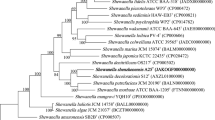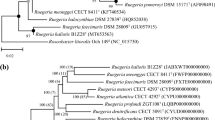Abstract
A Gram-negative, motile and rod-shaped bacterial strain, designated S7-3T, was isolated from a tidal flat sediment at Saemankum on the western coast of Korea. Phylogenetic analyses based on 16S rRNA gene and gyrB sequences showed that strain S7-3T belonged to the genus Shewanella, clustering with Shewanella decolorationis S12T. Strain S7-3T exhibited 98.8 % 16S rRNA gene sequence similarity and 96.8 % gyrB sequence similarity to S. decolorationis S12T, respectively. The 16S rRNA gene sequence similarity values between strain S7-3T and other members of the genus Shewanella were in the range of 93.0–98.0 %. Strain S7-3T contained simultaneously both menaquinones (MK) and ubiquinones (Q); the predominant menaquinone was MK-7 and the predominant ubiquinones were Q-7 and Q-8. The fatty acid profiles of strain S7-3T and S. decolorationis JCM 21555T were similar; major components were C17:1 ω8c, iso-C15:0 and iso-C15:0 2-OH and/or C16:1 ω7c. The DNA G+C content of strain S7-3T was 51.8 mol% and its mean DNA–DNA relatedness value with S. decolorationis JCM 21555T was 43 %. Differential phenotypic properties of strain S7-3T, together with the phylogenetic and genetic distinctiveness, revealed that this strain is distinguishable from recognized Shewanella species. On the basis of the data presented, strain S7-3T is considered to represent a novel Shewanella species, for which the name Shewanella seohaensis sp. nov. is proposed. The type strain is S7-3T (=KCTC 23556T = CCUG 60900T).


Similar content being viewed by others
References
Anzai Y, Kim H, Park JY, Wakabayashi H, Oyaizu H (2000) Phylogenetic affiliation of the pseudomonads based on 16S rRNA sequence. Int J Syst Evol Microbiol 50:1563–1589
Baumann P, Baumann L (1981) The marine Gram-negative eubacteria: genera Photobacterium, Beneckea, Alteromonas, Pseudomonas, and Alcaligenes. In: Starr MP, Stolp H, Trüper HG, Balows A, Schlegel HG (eds) The prokaryotes. Springer, Berlin, pp 1302–1331
Bruns A, Rohde M, Berthe-Corti L (2001) Muricauda ruestringensis gen. nov., sp. nov., a facultatively anaerobic, appendaged bacterium from German North Sea intertidal sediment. Int J Syst Evol Microbiol 51:1997–2006
Cohen-Bazire G, Sistrom WR, Stanier RY (1957) Kinetic studies of pigment synthesis by nonsulfur purple bacteria. J Cell Comp Physiol 49:25–68
Cowan ST, Steel KJ (1965) Manual for the identification of medical bacteria. Cambridge University Press, London
Euzéby JP (1997) List of bacterial names with standing in nomenclature: a folder available on the Internet. Int J Syst Bacteriol 47:590–592 (list of prokaryotic names with standing in nomenclature. last full update: January 12, 2012. http://www.bacterio.net)
Ezaki T, Hashimoto Y, Yabuuchi E (1989) Fluorometric deoxyribonucleic acid-deoxyribonucleic acid hybridization in microdilution wells as an alternative to membrane filter hybridization in which radioisotopes are used to determine genetic relatedness among bacterial strains. Int J Syst Bacteriol 39:224–229
Komagata K, Suzuki KI (1987) Lipid and cell wall analysis in bacterial systematics. Methods Microbiol 19:161–207
Lányí B (1987) Classical and rapid identification methods for medically important bacteria. Methods Microbiol 19:1–67
Leifson E (1963) Determination of carbohydrate metabolism of marine bacteria. J Bacteriol 85:1183–1184
MacDonell MT, Colwell RR (1985) Phylogeny of the Vibrionaceae, and recommendation for two new genera, Listonella and Shewanella. Syst Appl Microbiol 6:171–182
Sasser M (1990) Identification of bacteria by gas chromatography of cellular fatty acids. MIDI technical note 101. Microbial ID, Inc., Newark
Stackebrandt E, Goebel BM (1994) Taxonomic note: a place for DNA–DNA reassociation and 16S rRNA sequence analysis in the present species definition in bacteriology. Int J Syst Bacteriol 44:846–849
Staley JT (1968) Prosthecomicrobium and Ancalomicrobium: new prosthecate freshwater bacteria. J Bacteriol 95:1921–1942
Tamaoka J, Komagata K (1984) Determination of DNA base composition by reverse-phase high-performance liquid chromatography. FEMS Microbiol Lett 25:125–128
Teather RM, Wood PJ (1982) Use of Congo red-polysaccharide interactions in enumeration and characterization of cellulolytic bacteria from the bovine rumen. Appl Environ Microbiol 43:777–780
Wayne LG, Brenner DJ, Colwell RR, Grimont PAD, Kandler O, Krichevsky MI, Moore LH, Moore WEC, Murray RGE et al (1987) International committee on systematic bacteriology. Report of the ad hoc committee on reconciliation of approaches to bacterial systematics. Int J Syst Bacteriol 37:463–464
Xu M, Guo J, Cen Y, Zhong X, Cao W, Sun G (2005) Shewanella decolorationis sp. nov., a dye-decolorizing bacterium isolated from activated sludge of a waste-water treatment plant. Int J Syst Evol Microbiol 55:363–368
Yamamoto S, Harayama S (1995) PCR amplification and direct sequencing of gyrB genes with universal primers and their application to the detection and taxonomic analysis of Pseudomonas putida strains. Appl Environ Microbiol 61:1104–1109
Yoon JH, Kim H, Kim SB, Kim HJ, Kim WY, Lee ST, Goodfellow M, Park YH (1996) Identification of Saccharomonospora strains by the use of genomic DNA fragments and rRNA gene probes. Int J Syst Bacteriol 46:502–505
Yoon JH, Lee ST, Park YH (1998) Inter- and intraspecific phylogenetic analysis of the genus Nocardioides and related taxa based on 16S rDNA sequences. Int J Syst Bacteriol 48:187–194
Yoon JH, Kim IG, Shin DY, Kang KH, Park YH (2003) Microbulbifer salipaludis sp. nov., a moderate halophile isolated from a Korean salt marsh. Int J Syst Evol Microbiol 53:53–57
Yoon JH, Lee SY, Kang SJ, Lee CH, Oh TK (2007) Pseudoruegeria aquimaris gen. nov., sp. nov., isolated from seawater of the East Sea in Korea. Int J Syst Evol Microbiol 57:542–547
Acknowledgements
This work was supported by the Program for Collection, Management and Utilization of Biological Resources (grant M10867010003) and BK 21 program from the Ministry of Education, Science and Technology (MEST) of the Republic of Korea.
Author information
Authors and Affiliations
Corresponding author
Additional information
The GenBank accession numbers of the 16S rRNA gene sequence and gyrB sequence of Shewanella seohaensis S7-3T are GU944672 and GU944673, respectively.
Rights and permissions
About this article
Cite this article
Yoon, JH., Park, S., Jung, YT. et al. Shewanella seohaensis sp. nov., isolated from a tidal flat sediment. Antonie van Leeuwenhoek 102, 149–156 (2012). https://doi.org/10.1007/s10482-012-9722-2
Received:
Accepted:
Published:
Issue Date:
DOI: https://doi.org/10.1007/s10482-012-9722-2




